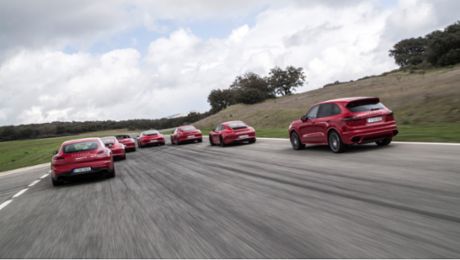Sporty abbreviation with tradition
GTS stands for ‘Gran Turismo Sport’ and identifies Porsche cars of all model series that are equally impressive on the racing track and on the road. This history of the abbreviation at Porsche goes all the way back to 1964, when a Porsche 904 Carrera GTS won the Targa Florio, the legendary Italian race in Sicily.
In 2007, the Porsche Cayenne was the first series model of the modern era to bear the ‘GTS’ suffix. Ever since, these three letters have represented an extra level of performance and a high standard of comfort at Porsche. The first Cayenne GTS was distinguished by two key features: its increased performance compared to the S model, and its distinctive special colours and black trim elements. It was positioned as an attractive product between the S and Turbo models. Over the years, the GTS has established itself as the sportiest Cayenne variant.
Porsche presented the first Cayenne GTS (known internally as generation E1 II) at the IAA in Frankfurt in 2007. It had a V8 engine with modified air intake and produced 298 kW (405 PS). Chassis optimisations provided significantly improved longitudinal and lateral dynamics. GTS fans still fondly remember the striking exterior and throaty V8 sound of the first Cayenne GTS. Shortly thereafter, a Porsche Design edition limited to 1,000 cars was launched in the form of the Cayenne GTS PDE 3 (also E1 II), distinguished by its special colour scheme and exclusive exterior and interior design.
Porsche presented the second generation of the Cayenne GTS (E2) in Beijing in 2012. With 309 kW (420 PS), it produced more power than its predecessor and accelerated from 0 to 100 km/h in just 5.7 seconds. The Cayenne GTS underlined the company’s goal of also establishing itself as a sports car manufacturer within the SUV segment. Alongside its performance, the GTS also impressed with its exclusivity. For example, with its distinctive colours, the GTS package gave the interior an especially high-quality appearance.
First presented in Los Angeles in 2014, the comprehensively reworked Cayenne GTS (E2 II) incorporated black design elements for an emphatically sporty, unique look. The car’s powertrain was based on the downsizing strategy: for the first time, the Cayenne GTS came with a twin-turbo V6 engine – and even greater driving performance. Compared to its predecessor, the new engine produced an additional 20 PS and 85 Nm more torque. Accelerating from 0 to 100 km/h in 5.1 seconds, it was even faster than its predecessor.
For the third Cayenne generation (2020), Porsche made two fundamental changes to the GTS models. Instead of the six-cylinder engine, a 4.0-litre twin-turbo V8 engine provided increased power and even more impressive driving performance than its predecessor: 338 kW (460 PS) and a maximum torque of 620 Nm accelerated the model from 0 to 100 km/h in 4.5 seconds. In addition, with the Cayenne GTS Coupé (internally known as the E3), a second body variant of the Cayenne GTS was launched for the first time. Ever since, it has stood alongside the Cayenne GTS SUV. Both derivatives offer impressive lateral driving dynamics.
Porsche positions the Cayenne GTS Coupé as an even more performance-focused model than the SUV. For example, the standard equipment includes the Sport Chrono package, which features a stopwatch and the Sport Response button. Lightweight packages are also optionally available, which reduce the weight and feature a specially tuned sports exhaust system delivering a significantly more distinctive sound.
From 2024, with generation E3 II, the Cayenne GTS (Cayenne GTS: Fuel consumption* combined (WLTP) 12.7 – 12.2 l/100 km, CO₂ emissions* combined (WLTP) 289 – 277 g/km, CO₂ class G , CO₂ class weighted combined G ) will be even more powerful, producing 368 kW (500 PS). Porsche has sharpened up the chassis and the exterior design, positioning the Cayenne GTS models as even more engaging and dynamic – while offering the same uncompromised everyday usability.




